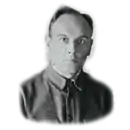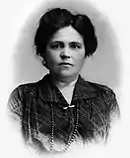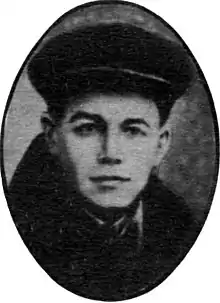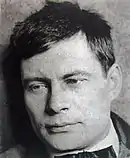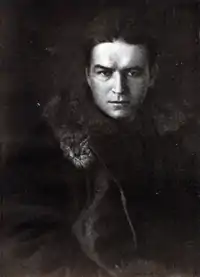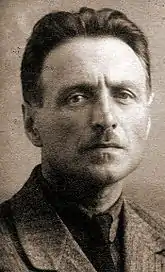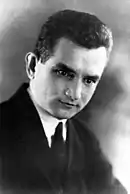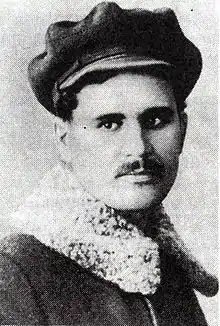Executed Renaissance
Executed Renaissance (Ukrainian: Розстріляне відродження, Червоний ренесанс, romanized: Rozstriliane vidrodzhennia, Chervonyi renesans) is a term used to describe the generation of Ukrainian language poets, writers, and artists of 1920s and early 1930s who were living in the Ukrainian Socialist Soviet Republic. After the Great Turn, when new Soviet General Secretary Joseph Stalin decided to reverse the Post-Bolshevik Revolution policies of Korenizatsiya and Ukrainianization, these outwardly Pro-Soviet poets and writers refused to submit to Stalin's decision to return to the House of Romanov's policy of the coercive Russification of Ukraine. Ukrainian language poets and writers were accordingly arrested en masse and then executed or repressed, in many cases at the Sandarmokh execution and mass grave site in Karelia, as a preliminary to the Holodomor. The term "The Executed Renaissance" was first suggested by anti-communist Polish emigre publisher Jerzy Giedroyc in a 1959 letter to Ukrainian emigre and literary critic Yurii Lavrinenko as a title for a planned anthology of the best Ukrainian literature ever written by that generation.[1]
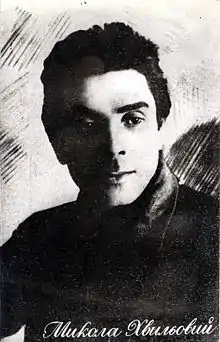
(1893-1933)
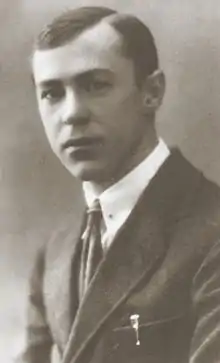
(1901-1937)
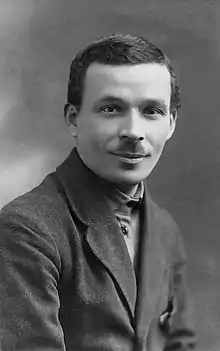
(1892-1937)
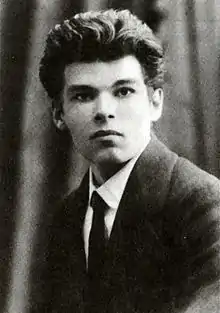
(1892-1937)

(1887-1937)
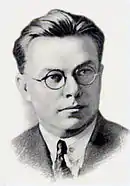
(1890-1937)
Background
The downfall of the Russian Empire after the First World War, the resulting abolition of imperial censorship, the establishment of an independent Ukrainian state, and the cultural leniency the Soviet regime displayed in the 1920s all led to an astonishing renaissance of literary and cultural activity in Ukraine.[2] Scores of new writers and poets appeared and formed dozens of literary groups that changed the face of Ukrainian literature.[3] These processes were supported by politics of nativization (in Ukraine it was called Ukrainization), New Economic Policy (state capitalism) and elimination of illiteracy.
Name
The term the “Executed Renaissance” was proposed by Jerzy Giedroyc, the editor of the Kultura publishing cooperative based in Paris and devoted to publishing anti-communist writers from throughout the Polish diaspora.[4] Giedroyc first used this phrase in a letter to Yuri Lavrinenko dated August 13, 1958, and suggested it as the title of an anthology of Ukrainian literature from 1917-1933, which Lavrinenko had prepared at the request of Kultura: "About the name. Could it be better to give it a generic name: “Executed Renaissance. Anthology 1917-1933 etc."The name would then sound spectacular. On the other hand, the humble nameAnthology can only facilitate penetration by the Iron Curtain. What do you think?". Lavrinenko replied, "So be it".
The anthology "The Executed Renaissance: Anthology from 1917–1933: Poetry—prose—drama—essay" appeared with the initiative and expense of Jerzy Giedroyc through Kultura in Paris in 1959 and remains one of the most important sources for the history of Ukrainian literature during that period.[5] It represents the best examples of Ukrainian poetry, prose and essay writing in the 1920s and 1930s.
According to researcher of Ukrainian literature of the 1920s Yarina Tsymbal, "Executed Renaissance" was a good name for the anthology, but unsuitable for the whole generation of creative intelligentsia. The "Red Renaissance", in her view, is a more apt metaphor because it is a self-title. It first appeared in 1925, when both the book "Renaissance of Ukrainian Literature" by Olexander Leites and the poem "The Call of the Red Renaissance" by Volodymyr Gadzinskyi[6] were published simultaneously and independently. The same year, the magazine Neo-Lif was published, with a preface to which, also written by Gadzinskyi, it stated: "For us, the past is only a means of cognizing the present and future, a useful experience and important practice in the great structure of the Red Renaissance."[7]
New elite
Lavrinenko, however, saw the Executed Renaissance as more than just a title of an anthology and introduced it as a term that encapsulates both the martyrdom of Ukrainian poets and writers while also representing their legacy and power to resurrect Ukrainian culture.[4] The Executed Renaissance paradigm - along with the national communist perspective and the framework to nationalize Ukraine's early Soviet intellectuals - would later emerge as a component of an effort to establish a national opposition to the Communist regime with the new intellectual elite eventually contributing to a struggle for an independent and united country.[8]
The main components of the outlook of the new Ukrainian intellectuals were rebellion, independent thought, and genuine belief in their own ideals. Mostly, it was the intellectuals who bet on the individual, rather than on the masses. Like many other perpetrators of inner emigration in a police state, their outward "Sovietness" concealed deep searches and queries.
Coming out of the lower classes (servants, families of priests, industrial workers, and peasants), the new generation of the Ukrainian elite often did not have the opportunity to receive systematic education because of war, famine and the need to earn daily bread. But, working "on the brink of the possible", trying to use every opportunity to get acquainted with the world culture, to spread the wings of creativity, they were imbued with the latest trends and created really topical art.
At this time comes a new generation, with a moral burden of victories and defeats of the struggle for national independence, with an understanding of Ukraine's path in world history, independent in judgments, with diverse ideas about the development of Ukrainian literature, when, according to S. Pavlychko, literature “got a much wider audience than ever before. The level of education of this audience has increased. For the first time, a large number of writers and intellectuals worked in literature. For the first time Ukrainian scientists spoke to the audience of national universities. For the first time different artistic directions, groups, and schools were rapidly differentiated. However, the tendency for the modernization of cultural life coexisted from the outset with a parallel tendency for its subordination to ideology and then to complete destruction.[9]
Literary process
Writers mostly were consolidated into literary organizations with different styles or positions. The period between 1925 and 1928 was characterized by "literature discussion" on the initiative of Mykola Khvylovy. An object of the discussion was ways of development for new Ukrainian Soviet literature and role of writer in society. Khvylovy and his associates were supporting an orientation towards Western European culture instead of Russian, they were rejecting "red graphomania" (though they weren't rejecting Communism as political ideology).
The main literary organizations of that time were:
- "Hart" (Ukrainian: Гарт which means hardening) existed in 1923-25. Its main goal was uniting of all kinds of proletarian artists with further development of proletarian culture. One of the requirements of "Hart" was using of Ukrainian language. The organization ceased to exist after its leader Vasyl Ellan-Blakytny died.[10]
- VAPLITE (Ukrainian: ВАПЛІТЕ, shortened of Free Academy of Proletarian Literature) was created in 1926 by Mykola Khvylovy on the base of "Hart". Its goal was creating of new Ukrainian literature through adopting the best achievements of Western European culture. VAPLITE was accepting Communism as political ideology but they were rejecting necessity of ideological meaning of literature as the main requirement to it. Among members of VAPLITE were Oleksandr Dovzhenko, Mykola Kulish, Les Kurbas, Mayk Johansen, Pavlo Tychyna, Oleksa Slisarenko, Mykola Bazhan, Yurii Smolych, Yulian Shpol.[11]
- MARS (Ukrainian: МАРС, shortened of Workshop of revolutionary literature) existed in 1924-29 (primarily under name of "Lanka"). The main postulate of MARS was honestly and artistically describe that time epoch. Among its members were Valerian Pidmohylny, Hryhorii Kosynka, Yevhen Pluzhnyk, Borys Antonenko-Davydovych, Todos Osmachka, Ivan Bahrianyi, Maria Halych.
- "Aspanfut" (Ukrainian: Аспанфут), later Komunkult (Ukrainian: Комункульт) was an organization of Ukrainian futurists. Their values were "Communism, internationalism, industrialism, rationalization, inventions, quality".[12] Among its members were Mykhayl Semenko, Heo Shkurupii, Yurii Yanovsky, Yulian Shpol.
- Neoclassicists (Ukrainian: Неокласики) was a literary movement of modernists among whose followers were Mykola Zerov, Maksym Rylsky, Pavlo Fylypovych, Mykhailo Drai-Khmara. They never established a formal organization or program, but they shared cultural and esthetic interests. They were concerned with the production of high art and disdained "mass art", didactic writing, and propagandistic work.[13]
- "Pluh" (Ukrainian: Плуг which means plough) was an organization of rural writers. Their main postulate was "struggle against proprietary ideology among peasants and promoting of Proletarian revolution's ideals". Among its members were Serhii Pylypenko, Petro Panch, Dokiia Humenna, Andrii Holovko.[14]
- "Zakhidna Ukraina" (Ukrainian: Західна Україна; English: Western Ukraine) - since April 1926 separated from "Pluh" as independent literary organization containing 50 writers and artists that came from Western Ukrainian lands in Kyiv, Odesa, Dnipro, Poltava. Was headed by Dmytro Zagul, and later by Myroslav Irchan.
Innovation
The prose was divided into two streams: plot (narrative) prose and non-plot prose. In the non-plot works, the main thing was not the sentence or the word, but the subtext, the spirit, the "smell of the word", as Khvylovyi said.[15] The style of strong feelings and penetration of phenomena is called neo-romanticism or expressionism. Mykola Khvylovy, Yurii Yanovsky, Andrii Holovko, Julian Shpol, Oleksa Vlyko, Les Kurbas, Mykola Kulish and many others worked in this direction.
The main idea of the novel Ya (Romantyka) (I am (romance))[16] by Khvylovy is a disappointment in the revolution, the screaming contradictions and the split of man of that time. The main character is a person without a name, and therefore without personality, without soul. For the sake of revolution, he kills his mother and reprove himself with the question: "Was the revolution worth such a sacrifice?"
For the first time in Ukrainian literature, elements of the philosophy of existentialism emerged in Valeryan Pidmogylny's The City (novel). The main character in pursuit of pleasure goes from satisfying the physical to the highest religious needs. However, even in such complex subject matter, the writer does not turn the novel into a simple narrative of "people's" philosophy, but creatively comprehends it in its application to national worldview.
In poetry, the most interesting is the search for symbolists Olexandr Oles and Pavlo Tychyna. In his collection, The Clarinets of the Sun, Tychyna reflected the breadth of an educated and subtle mind who contemplates the richness of Ukrainian nature, wanting to get to its root causes.
When the Communist Party of the USSR realized its defeat, it began to operate with prohibited methods: repression, silence, crushing criticism, arrests, executions. The writers were faced with the choice of suicide (Khvylovyi), repression and concentration camps (Gulag) (B. Antonenko-Davidovich, Ostap Vyshnya), silence (Ivan Bahrianyi, V. Domontovich), emigration (V. Vynnychenko, Y. Malaniuk), or writing works on glorification of the party (P. Tychyna, Mykola Bazhan). Most of the artists were repressed and shot.
Repression, arrests, and executions
In late 1920s Stalin abolished the New Economic Policy and returned to forced collectivization. In this context changes in cultural politics occurred as well. An early example was the Union for the Freedom of Ukraine process in 1930, a show trial of 474 people (mostly scientists), 15 of whom were executed and 248 sent to prison.
The beginning of the mass extermination of the Ukrainian intelligentsia is May 1933, when Mykhailo Yalovyi was arrested and the suicide of Mykola Khvylovyi took place in the Kharkiv house "Slovo" (word).
The campaign was concentrated in the years from 1934 to 1940, reaching a peak during the Great Purge of 1937-1938. Overall, 223 writers were subjected to harassment, arrest and in a number of cases imprisonment and execution. The culmination of the actions of the Soviet repressive regime was the mass executions of the "counter-revolutionaries" committed on the eve of the 20th anniversary of the October coup. Almost three hundred representatives of the Ukrainian renaissance of the 1920s were shot between 27 October and 4 November at Sandarmokh, a massive killing field in Karelia (northwest Russia).[17]
Some important representatives of this generation survived. They remained in the Soviet Union (Oleksandr Dovzhenko, Pavlo Tychyna, Maksym Rylskyi, Borys Antonenko-Davydovych, Ostap Vyshnia, and Mykola Bazhan), or emigrated (Ulas Samchuk, George Shevelov, and Ivan Bahrianyi).
Scale of the tragedy
Exact data on the number of repressed Ukrainian intellectuals during the Stalinist repression of the period are not known. According to some, this number reached 30,000 people.[18] Instead, it is quite simple to determine the approximate number of repressed persons among the writers: the availability of their publications in the early and late 1930s. According to the estimation of the Association of Ukrainian Writers "Slovo" (the organization of Ukrainian writers in emigration), which was sent on December 20, 1954 to the Second All-Union Congress of Writers, in 1930 259 Ukrainian writers were printed, and after 1938 there were printed only 36 (13.9%). According to the organization, 192 of the "missing" 223 writers were repressed (executed or exiled to the camps with possible subsequent execution or death), 16 - disappeared, 8 - committed suicide.[19]
These data are in good agreement with the martyrologist of the Ukrainian writers of the "Altar of Sorrow" (chief compiler - Olexii Musiienko), who counted 246 writers victims of Stalin's terror.[20]
According to other sources, out of 260 Ukrainian writers, 228 were repressed.[21]
Representatives
- Hnat Khotkevych (31 December 1877 – 8 October 1938), writer, ethnographer, playwright, composer, musicologist and bandurist.
- Mykola Khvylovy (13 December 1893 – 13 May 1933) prose writer and poet.
- Hryhorii Kosynka (29 November 1899 – 15 December 1934), writer and translator.
- Mykola Kulish (19 December 1892 – 3 November 1937), prose writer and dramatist; shot at Sandarmokh.
- Les Kurbas (25 February 1887 – 3 November 1937), film and theater director; shot at Sandarmokh.
- Valerian Pidmohylny (2 February 1901 – 3 November 1937), prose writer; shot at Sandarmokh.
- Klym Polishchuk (25 November 1891 – 3 November 1937), journalist, poet and prose writer; shot at Sandarmokh.
- Liudmyla Starytska-Cherniakhivska[22] (17 August 1868 – 1941), writer, translator and literary critic.
- Mykhailo Yalovyi (5 June 1895 – 3 November 1937), poet, prosaist and dramatist; shot at Sandarmokh.
- Maik Yohansen (pseudonyms: Willy Wetzelius and M. Kramar) (16 October 1895 – 27 October 1937), poet, prose writer, dramatist, translator, critic and linguist; shot at Sandarmokh.
- Volodymyr Svidzinsky (9 October 1885 – 18 October 1941), poet and translator.
- Ivan Bahrianyi (2 October 1906 – 25 August 1963), writer, essayist, novelist and politician.
- Borys Antonenko-Davydovych (5 August 1899 — 8 May 1984), writer, translator and linguist.
- Mykhailo Boychuk (30 October 1882 - 13 July 1937), painter, most commonly known as a monumentalist.
- Mykhaylo Semenko (19 December 1892 — 24 October 1937), poet, the prominent representative of the Ukrainian futuristic poetry of the 1920s.
- Mykola Zerov (26 April 1890 - 3 November 1937), poet, translator, classical and literary scholar and critic.
- Yevhen Pluzhnyk (26 December 1898 — 2 February 1936), poet, playwright and translator.
- Hryhorii Epik (17 January 1901 – 3 November 1937), writer and journalist.
- Anton Prykhodko (1891 - 29 January 1938) — writer, statesman.
See also
References
- Lushnycky, Andrej N.; Riabchuk, Mykola (2009). Ukraine on Its Meandering Path Between East and West. Bern: Peter Lang. p. 185. ISBN 978-3-03911-607-2.
- Journal, Retrospect (2020-11-22). "Executed Renaissance: The Erasure of Ukrainian Cultural Heritage in the Times of the Soviet Union". Retrospect Journal. Retrieved 2022-02-24.
- HRYN, HALYNA (2004). "The Executed Renaissance Paradigm Revisited". Harvard Ukrainian Studies. 27 (1/4): 67–96. ISSN 0363-5570.
- Fedor, Julie (2016). Journal of Soviet and Post-Soviet Politics and Society: 2015/2: Double Special Issue: Back from Afghanistan: The Experiences of Soviet Afghan War Veterans and: Martyrdom & Memory in Post-Socialist Space. Stuttgart, Germany: Columbia University Press. ISBN 978-3-8382-6806-4.
- ""Executed Renaissance": today 70 years of beginning of extermination of Ukrainian elite". FrontNews. Retrieved 2019-09-16.
- "Ярина Цимбал: "Психологічний роман передував масовим жанрам"". ЛітАкцент - світ сучасної літератури (in Ukrainian). 2016-03-03. Retrieved 2019-09-16.
- "100 років українському футуризму / Centennial of Ukrainian Futurism". www.facebook.com. Retrieved 2019-09-16.
- Palko, Olena (2021). Making Ukraine Soviet: Literature and Cultural Politics under Lenin and Stalin. London: Bloomsbury Publishing. p. 14. ISBN 978-1-7883-1305-6.
- Павличко С. Дискурс модернізму в українській літературі: [монографія] / С. Павличко. — К.: Либідь, 1997. — C. 170.
- Нагорний К.О. Проблема національного самоствердження в публіцистиці лідера літературного угруповання "Гарт" В. Блакитного
- Ю. Луцький. Джерела до історії Вапліте
- Quote from futurists' manifest in their magazine "Nova Generatsiya".
- Neoclassicists
- Плуг
- Khomenko, Halyna (2018). "Mykola Khvylovyi and the French Republic of Literature: the Experience of Re-reading". Studia Polsko-Ukraińskie. 5: 111–122. doi:10.32612/uw.23535644.2018.pp.111-122. ISSN 2353-5644.
- Khvylovy, Mykola. I am (romance).
- Юрій Лавріненко Розстріляне відродження: Антологія 1917–1933. Archived December 13, 2010, at the Wayback Machine — Київ: Смолоскип, 2004.
- Червоний ренесанс. Фільм третій: Безодня (1930—1934). — Кіностудія «Контакт». 2004. — 12:06/51:33.
- Юрій Лавріненко. Розстріляне відродження: Антологія 1917—1933. Archived 2010-12-13 at the Wayback Machine — Київ: Смолоскип, 2004.
- Іменник мартиролога українського письменства // Микола Жулинський. Безодня української печалі… Archived 2010-10-21 at the Wayback Machine
- Червоний ренесанс. Фільм третій: Безодня (1930—1934). — Кіностудія «Контакт». 2004. — 47:01/51:33.
- Krys, Svitlana (2016) ‘Book Review: Liudmyla Starytska-Cherniakhivska, The Living Grave: A Ukrainian Legend and Klym Polishchuk, Treasure of the Ages: Ukrainian Legends’, EWJUS: East/West: Journal of Ukrainian Studies, Vol 3, No 2, pp. 213-215
Bibliography
- Юрій Лавріненко. Розстріляне відродження: Антологія 1917–1933. — Київ: Смолоскип, 2004.
- Розстріляне Відродження
- Orest Subtelny. Ukraine: A History. University of Toronto Press, 2000 - 736 p.
- Mace James Ernest. Communism and the Dilemmas of National Liberation: National Communism in Soviet Ukraine, 1918—1933 / James Earnest Mace, Harvard Ukrainian Research Institute, Ukrainian Academy of Arts and Sciences in the United States. Cambridge: Distributed by Harvard University Press for the Harvard Ukrainian Research Institute and the Ukrainian Academy of Arts and Sciences in the U.S., 1983. — 334 pp.
- Розстріляне Відродження
